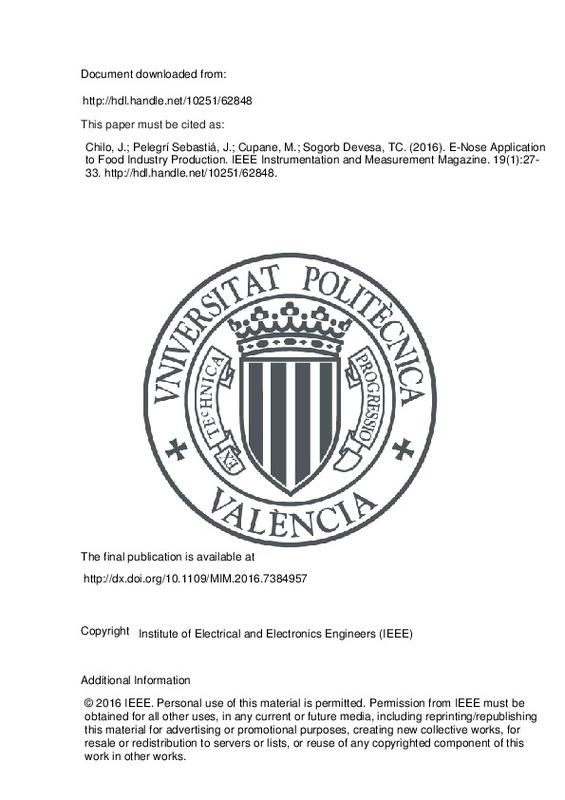JavaScript is disabled for your browser. Some features of this site may not work without it.
Buscar en RiuNet
Listar
Mi cuenta
Estadísticas
Ayuda RiuNet
Admin. UPV
E-Nose Application to Food Industry Production
Mostrar el registro sencillo del ítem
Ficheros en el ítem
| dc.contributor.author | Chilo, Jose
|
es_ES |
| dc.contributor.author | Pelegrí Sebastiá, José
|
es_ES |
| dc.contributor.author | Cupane, María
|
es_ES |
| dc.contributor.author | Sogorb Devesa, Tomás C.
|
es_ES |
| dc.date.accessioned | 2016-04-22T10:56:20Z | |
| dc.date.available | 2016-04-22T10:56:20Z | |
| dc.date.issued | 2016-02 | |
| dc.identifier.issn | 1094-6969 | |
| dc.identifier.uri | http://hdl.handle.net/10251/62848 | |
| dc.description | © 2016 IEEE. Personal use of this material is permitted. Permission from IEEE must be obtained for all other uses, in any current or future media, including reprinting/republishing this material for advertising or promotional purposes, creating new collective works, for resale or redistribution to servers or lists, or reuse of any copyrighted component of this work in other works. | es_ES |
| dc.description.abstract | Food companies worldwide must constantly engage in product development to stay competitive, cover existing markets, explore new markets, and meet key consumer requirements. This ongoing development places high demands on achieving quality at all levels, particularly in terms of food safety, integrity, quality, nutrition, and other health effects. Food product research is required to convert the initial product idea into a formulation for upscaling production with ensured significant results. Sensory evaluation is an effective component of the whole process. It is especially important in the last step in the development of new products to ensure product acceptance. In that stage, measurements of product aroma play an important role in ensuring that consumer expectations are satisfied. To this end, the electronic nose (e-nose) can be a useful tool to achieve this purpose. The e-nose is a combination of various sensors used to detect gases by generating signals for an analysis system. Our research group has investigated the scent factor in some foodstuff and attempted to develop e-noses based on low-cost technology and compact size. In this paper, we present a summary of our research to date on applications of the e-nose in the food industry. | es_ES |
| dc.language | Inglés | es_ES |
| dc.publisher | Institute of Electrical and Electronics Engineers (IEEE) | es_ES |
| dc.relation.ispartof | IEEE Instrumentation and Measurement Magazine | es_ES |
| dc.rights | Reserva de todos los derechos | es_ES |
| dc.subject | Electronic nose | es_ES |
| dc.subject | Food industry | es_ES |
| dc.subject | Gas detectors | es_ES |
| dc.subject | Pollution measurement | es_ES |
| dc.subject | Principal component analysis | es_ES |
| dc.subject | Production | es_ES |
| dc.subject | Sensor systems | es_ES |
| dc.subject.classification | TECNOLOGIA ELECTRONICA | es_ES |
| dc.title | E-Nose Application to Food Industry Production | es_ES |
| dc.type | Artículo | es_ES |
| dc.identifier.doi | 10.1109/MIM.2016.7384957 | es_ES |
| dc.rights.accessRights | Abierto | es_ES |
| dc.contributor.affiliation | Universitat Politècnica de València. Departamento de Ingeniería Electrónica - Departament d'Enginyeria Electrònica | es_ES |
| dc.contributor.affiliation | Universitat Politècnica de València. Instituto de Investigación para la Gestión Integral de Zonas Costeras - Institut d'Investigació per a la Gestió Integral de Zones Costaneres | es_ES |
| dc.description.bibliographicCitation | Chilo, J.; Pelegrí Sebastiá, J.; Cupane, M.; Sogorb Devesa, TC. (2016). E-Nose Application to Food Industry Production. IEEE Instrumentation and Measurement Magazine. 19(1):27-33. doi:10.1109/MIM.2016.7384957 | es_ES |
| dc.description.accrualMethod | S | es_ES |
| dc.relation.publisherversion | http://dx.doi.org/10.1109/MIM.2016.7384957 | es_ES |
| dc.description.upvformatpinicio | 27 | es_ES |
| dc.description.upvformatpfin | 33 | es_ES |
| dc.type.version | info:eu-repo/semantics/publishedVersion | es_ES |
| dc.description.volume | 19 | es_ES |
| dc.description.issue | 1 | es_ES |
| dc.relation.senia | 300315 | es_ES |
| dc.identifier.eissn | 1941-0123 |







![[Cerrado]](/themes/UPV/images/candado.png)

